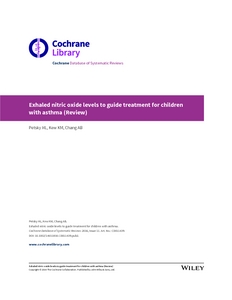Petsky, HL; Kew, KM; Chang, AB
(2016)
Exhaled nitric oxide levels to guide treatment for children with asthma.
Cochrane Database Syst Rev, 11.
CD011439.
ISSN 1469-493X
https://doi.org/10.1002/14651858.CD011439.pub2
SGUL Authors: Kew, Kayleigh Marie
![[img]](https://openaccess.sgul.ac.uk/108412/1.hassmallThumbnailVersion/FENO1-AST.pdf)  Preview |
|
PDF
Published Version
Available under License ["licenses_description_publisher" not defined].
Download (769kB)
| Preview
|
Abstract
BACKGROUND: Asthma guidelines aim to guide health practitioners to optimise treatment for patients to minimise symptoms, improve or maintain good lung function, and prevent acute exacerbations. The principle of asthma guidelines is based on a step-up or step-down regimen of asthma medications to maximise health using minimum doses. Fractional exhaled nitric oxide (FeNO) is a marker of eosinophilic inflammation and tailoring asthma medications in accordance to airway eosinophilic levels may improve asthma outcomes such as indices of control or reduce exacerbations, or both. OBJECTIVES: To evaluate the efficacy of tailoring asthma interventions based on fractional exhaled nitric oxide (FeNO), in comparison to not using FeNO, that is, management based on clinical symptoms (with or without spirometry/peak flow) or asthma guidelines (or both), for asthma-related outcomes in children. SEARCH METHODS: We searched the Cochrane Airways Group Specialised Register of Trials, the Cochrane Central Register of Controlled Trials (CENTRAL), MEDLINE, Embase and reference lists of articles. The last searches were in June 2016. SELECTION CRITERIA: All randomised controlled trials (RCTs) comparing adjustment of asthma medications based on FeNO levels compared to those not using FeNO, that is, management based on clinical symptoms or asthma guidelines (or both) involving children. DATA COLLECTION AND ANALYSIS: We reviewed results of searches against predetermined criteria for inclusion. Two review authors independently selected relevant studies, assessed trial quality and extracted data. We contacted study authors for further information with responses provided from three. MAIN RESULTS: The review included nine studies; these studies differed in a variety of ways including definition of asthma exacerbations, FeNO cut-off levels used (12 parts per billion (ppb) to 30 ppb), the way in which FeNO was used to adjust therapy and duration of study (6 to 12 months). Of 1426 children randomised, 1329 completed the studies. The inclusion criteria for the participants in each study varied but all had a diagnosis of asthma. There was a significant difference in the number of children having one or more asthma exacerbations over the study period, they were significantly lower in the FeNO group in comparison to the control group (odds ratio (OR) 0.58, 95% confidence interval (CI) 0.45 to 0.75; 1279 participants; 8 studies). The number needed to treat for an additional beneficial outcome (NNTB) over 52 weeks was 9 (95% CI 6 to 15). There was no difference between the groups when comparing exacerbation rates (mean difference (MD) -0.37, 95% CI -0.8 to 0.06; 736 participants; 4 studies; I(2) = 67%). The number of children in the FeNO group requiring oral corticosteroid courses was lower in comparison to the children in the control group (OR 0.63, 95% CI 0.48 to 0.83; 1169 participants; 7 studies; I(2) = 0%). There was no statistically significant difference between the groups for exacerbations requiring hospitalisation (OR 0.75, 95% CI 0.41 to 1.36; 1110 participants; 6 studies; I(2) = 0%). There were no significant differences between the groups for any of the secondary outcomes (forced expiratory volume in one second (FEV1), FeNO levels, symptom scores or inhaled corticosteroid doses at final visit). The included studies recorded no adverse events.Three studies had inadequate blinding and were thus considered to have a high risk of bias. However, when these studies were removed in subgroup analysis, the difference between the groups for the primary outcome (exacerbations) remained statistically significant. The GRADE quality of the evidence ranged from moderate (for the outcome 'Number of participants who had one or more exacerbations over the study period') to very low (for the outcome 'Exacerbation rates'), based on lack of blinding, statistical heterogeneity and imprecision. AUTHORS' CONCLUSIONS: In this updated review with five new included studies, tailoring asthma medications based on FeNO levels (in comparison with primarily guideline management) significantly decreased the number of children who had one or more exacerbations over the study period but did not impact on the day-to-day clinical symptoms or inhaled corticosteroid doses. Therefore, the use of FeNO to guide asthma therapy in children may be beneficial in a subset of children, it cannot be universally recommended for all children with asthma.Further RCTs need to be conducted and these should encompass different asthma severities, different settings including primary care and less affluent settings, and consider different FeNO cut-offs.
| Item Type: |
Article
|
| Additional Information: |
Copyright © 2016 The Cochrane Collaboration. Published by John Wiley & Sons, Ltd. This review is published as a Cochrane Review in the Cochrane Database of Systematic Reviews 2016, Issue 11. Cochrane Reviews are regularly updated as new evidence emerges and in response to comments and criticisms, and the Cochrane Database of Systematic Reviews should be consulted for the most recent version of the Review. Petsky HL, Kew KM, Chang AB. Exhaled nitric oxide levels to guide treatment for children with asthma. Cochrane Database of Systematic Reviews 2016, Issue 11. Art. No.: CD011439. DOI: 10.1002/14651858.CD011439.pub2. |
| Keywords: |
General & Internal Medicine, 11 Medical And Health Sciences |
| SGUL Research Institute / Research Centre: |
Academic Structure > Population Health Research Institute (INPH) |
| Journal or Publication Title: |
Cochrane Database Syst Rev |
| ISSN: |
1469-493X |
| Language: |
ENG |
| Dates: |
| Date | Event |
|---|
| 9 November 2016 | Published | | 9 November 2016 | Accepted |
|
| Publisher License: |
Publisher's own licence |
| PubMed ID: |
27825189 |
 |
Go to PubMed abstract |
| URI: |
https://openaccess.sgul.ac.uk/id/eprint/108412 |
| Publisher's version: |
https://doi.org/10.1002/14651858.CD011439.pub2 |
Statistics
Item downloaded times since 07 Mar 2017.
Actions (login required)
 |
Edit Item |



